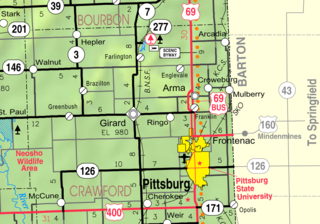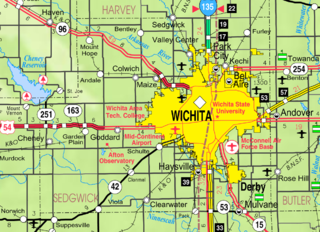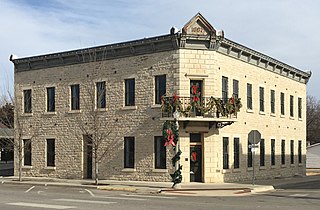
Leon is a city in Butler County, Kansas, United States. As of the 2020 census, the population of the city was 669.

McCune is a city in Crawford County, Kansas, United States. As of the 2020 census, the population of the city was 370.

Mulberry is a city in Crawford County, Kansas, United States. As of the 2020 census, the population of the city was 409.

Manchester is a city in Dickinson County, Kansas, United States. As of the 2020 census, the population of the city was 47.

Gove City, more commonly known as Gove, is a city in and the county seat of Gove County, Kansas, United States. As of the 2020 census, the population of the city was 80.

Meriden is a city in Jefferson County, Kansas, United States. As of the 2020 census, the population of the city was 744.

Edgerton is a city in Johnson County, Kansas, United States, and part of the Kansas City metropolitan area. As of the 2020 census, the population of the city was 1,748. It is home to a large BNSF intermodal train facility named Logistics Park Kansas City.

Kingman is a city in and the county seat of Kingman County, Kansas, United States. As of the 2020 census, the population of the city was 3,105.

Barnard is a city in Lincoln County, Kansas, United States. As of the 2020 census, the population of the city was 64.

Meade is a city in and the county seat of Meade County, Kansas, United States. As of the 2020 census, the population of the city was 1,505.

Centralia is a city in Nemaha County, Kansas, United States. As of the 2020 census, the population of the city was 485.

Ness City is a city in and the county seat of Ness County, Kansas, United States. As of the 2020 census, the population of the city was 1,329. Ness City is famous for its four-story Old Ness County Bank Building located downtown and nicknamed Skyscraper of the Plains.

Atwood is a city in and the county seat of Rawlins County, Kansas, United States. As of the 2020 census, the population of the city was 1,290.

Ogden is a city in Riley County, Kansas, United States. As of the 2020 census, the population of the city was 1,661. It is located near Fort Riley between Manhattan and Junction City.

Andale is a city in Sedgwick County, Kansas, United States. As of the 2020 census, the population of the city was 941.

Mount Hope is a city in Sedgwick County, Kansas, United States. As of the 2020 census, the population of the city was 806.

Mayfield is a city in Sumner County, Kansas, United States. As of the 2020 census, the population of the city was 75.

Alma is a city in and the county seat of Wabaunsee County, Kansas, United States. As of the 2020 census, the population of the city was 802.

Lake Quivira is a city in Johnson and Wyandotte counties in the State of Kansas, and part of the Kansas City Metropolitan Area. As of the 2020 census, the population of the city was 1,014.

Lebo is a city in Coffey County, Kansas, United States. As of the 2020 census, the population of the city was 885.






















